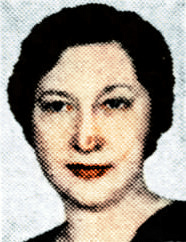Führer HQ (April 21, 1945)
Kommuniqué des Oberkommandos der Wehrmacht
In der großen Schlacht zwischen dem Stettiner Haff und den Sudeten wehrten sich unsere Truppen mit verbissener Entschlossenheit gegen den Ansturm der Bolschewisten. Ans engem Raum zusammengefasste Panzerarmeen des Feindes haben die Front an mehreren Stellen aufgerissen. An stehengebliebenen Frontteilen und in der Tiefe des Schlachtfeldes leisten eigene Kampftruppen hartnäckig Widerstand und fesseln starke Kräfte der Sowjets. Nordwestlich Görlitz stehen unsere Panzer in der Abwehr heftiger Angriffe. Gegenangriffe gewannen an einzelnen Stellen Boden. Aus der Einbruchslücke südlich Sprembergs trieb der Feind seine Panzerspitzen bis in den Raum von Kamenz vor. Die tapferen Besatzungen von Bautzen und Spremberg zerschlugen alle Angriffe. Zwischen Spremberg und Cottbus führten die Bolschewisten starke Panzerkräfte nach. Vorgeworfene Teile drangen bis in die Räume Jüterbog und Wilnsdorf vor, wo Kämpfe im Gange sind. Im Abschnitt Görlitz-Cottbus wurden in den Leiden letzten Tagen 211 Panzer vernichtet. Bei Frankfurt schlugen unsere Verbände alle Angriffe zurück. Im Raum östlich Berlin wird in der Linie Fürstenwalde-Straußberg-Bernau erbittert gekämpft. Angriffe gegen diese Orte brachen verlustreich für den Feind zusammen. Die Bolschewisten dehnten ihre Angriffe auch ans die nördliche Oderfront aus, wo zwischen Schwedt und Stettin zahlreiche Übersetzversuche vereitelt wurden. Zwei örtliche Brückenköpfe sind abgeriegelt. Fliegende Verbände und im Erdkampf eingesetzte Flak der Luftwaffe griffen wirksam in die Erdkämpfe ein und vernichteten 75 Panzerkampfwagen und mehrere hundert Kraftfahrzeuge. 200 Flugzeuge wurden abgeschossen. Im Süden der Ostfront scheiterten erneute Durchbruchsversuche der Sowjets südlich St. Pölten, nördlich Mistelbach und nordöstlich Mährisch-Ostrau. Zahlreiche Panzer wurden vernichtet. Segen die Westfront der Festung Breslau geführte Angriffe in Divisionsstärke blieben bis auf einen geringen Einbruch erfolglos. Gegen die Festung Pillau nahm der Feind seine Angriffe mit starkem Materialeinsatz wieder aus, der erstrebte Durchbruch blieb ihm aber versagt.
Die Seefestung Gironde-Süd wurde gestern nach Verschluss der letzten Munition und nachhaltiger Zerstörung der Hafenanlagen vom Gegner überwältigt. An der unteren Ems drängte der Gegner unsere Truppen nach heftigem Kampf bei Aschendorf in den Raum beiderseits Papenburgs zurück. Nördlich Friesoythe sind heftige Kämpfe um einen feindlichen Brückenkops am Küstenkanal im Gange. Beiderseits Delmenhorsts, in dessen Südteil der Gegner eindrang, und südlich Bremen hat sich die Lage bei wechselvollen Kämpfen nicht verändert. Die aus der Lüneburger Heide nach Norden angreifenden britischen Divisionen erreichten auf breiter Front die Elbe, wurden jedoch an unseren Brückenköpfen bei Ardenburg verlustreich abgeschlagen. Im Harz dauern die schweren Abwehrkämpfe um den Brocken im Abschnitt Eligenrode und mit den von Osten gegen den unteren Harz angreifenden feindlichen Kräften an. Am Brückenkopf von Dessau brachen stärkere Angriffe amerikanischer Infanterie- und Panzerverbände unter hohen Verlusten zusammen. Weiter südlich toben erbitterte Kämpft mit dem in Bitterfeld und Delitzsch eingedrungenen Feind. Während sich der Gegner im Großraum Chemnitz—Planen auf örtliche Ausklärungsvorstöße beschränkte, erzwang er an der Elster und im Fichtelgebirge trotz zäher Gegenwehr unserer Truppen tiefere Einbrüche. Südöstlich und südlich von Nürnberg, dessen tapfere Besatzung, aus engen Raum zusammengedrängt, dem Feinde weiter zähen Widerstand leistet, verhinderten unsere Verbände größeren Bodengewinn der mit starken Kräften nach Süden angreifenden Amerikaner. Die in den Meinhartwald vorgestoßenen feindlichen Kräfte konnten ihren Einbruch nach Süden erweitern und erreichten mit vorgeworfenen Ausklärungsverbänden den Raum von Göttingen. Gleichzeitig verstärkte sich der Druck ans der Linie Heilbronn-Pforzheim. Aus einem Einbruchsraum bei Tübingen gewann der Gegner in schweren Wald- und Ortskämpften nach Nordosten Raum.
Die schwere Abwehrschlacht an der italienischen Südfront nahm in den bisherigen Schwerpunkträumen mit gleichbleibender Heftigkeit ihren Fortgang. In schweren, äußerst harten Kämpfen, die vom Feinte weiterhin mit Hohem Materialeinsatz gefühlt wurden, verhinderten unsere tapferen Divisionen alle Durchbruchsversuche des Gegners.
Der Großraum Berlin war gestern das Angriffsziel amerikanischer Bomberverbände. Außerdem wurden zahlreiche süddeutsche Orte durch schwächere Verbände mit Bomben belegt. In der Nacht wurden wiederum Wohnviertel der Reichshauptstadt von Terrorfliegern bombardiert.
